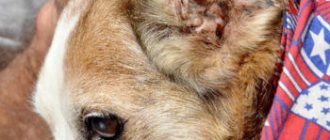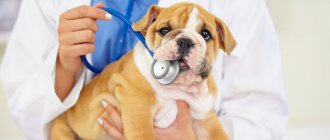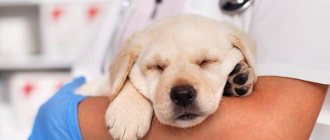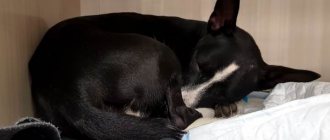Stomach ulcers in dogs
Dogs are the most intelligent, loyal and obedient pets that faithfully serve humans. But, unfortunately, not all of them are picky eaters, which negatively affects their health. In addition, often the owners themselves do not provide their pets with proper nutrition and do not particularly watch what goes into their mouths. As a result, animals suffer from diseases of the gastrointestinal tract, and canine stomach ulcers are often diagnosed. What kind of disease is this, and how is it dangerous for your four-legged friend?
Diagnosis of gastric ulcer
Gastric ulcers in dogs most often occur in a chronic form, so it is almost impossible to notice signs of the disease at the first stage. If you suspect that your pet is sick, contact an experienced veterinarian in Moscow. Only a specialist can make the correct diagnosis and prescribe effective treatment.
Methods used to diagnose ulcers:
- gastroscopy,
- blood tests (general, biochemical),
- ultrasound examination (ultrasound),
- radiographic examination,
- coagulogram.
First of all, the veterinarian examines the pet and interviews the owner. You need to answer several questions (how long have the symptoms of the disease been observed, how often do vomiting attacks occur, etc.). The specialist then issues referrals for laboratory tests if they are necessary to make a diagnosis.
Causes of development of peptic ulcer
An ulcer is an eroded area of the gastric mucosa that occurs due to the interaction of tissue with pepsin and hydrochloric acid. Therefore, the pathology is often called peptic. In acute lesions, the mucous membrane is covered with multiple erosions; in chronic lesions, they are focal in nature, penetrating deep into the tissues, and the edges of the ulcers rise.
Peptic ulcer disease often occurs against the background of an inflammatory process that occurs in the stomach. Without timely, competent treatment, due to non-compliance with the therapeutic regimen, the course of gastritis can become significantly more complicated.
The provoking factors leading to the appearance of ulcers are the following disorders in the dog’s diet:
- feeding your pet scraps from your own table; the most harmful to it are spicy, pickled, salty foods;
- hot or, conversely, excessively cold foods, drinks;
- lack of a meal schedule - this often happens when the dog guards the summer house all year round.
In addition, stomach ulcers may appear and then worsen when the animal is frequently stressed. Dogs are quite sensitive; their attachment to their owner and family often causes serious disturbances in the functioning of the body. Nervous tension can be caused by the following changes:
- change of owner;
- using unusual teaching techniques;
- undergoing medical procedures;
- change of place of residence;
- excessive physical activity.
Incorrect drug therapy, prescribed by an inexperienced veterinarian or carried out by the owner himself, can also cause ulceration of the gastric walls. Risks increase in the following cases:
- when using steroidal anti-inflammatory drugs;
- while taking medications undiluted with dry food granules.
In addition to inflammation of the stomach - gastritis, peptic ulcer disease can develop due to the presence of a number of such pathologies:
- malignant tumor formations - lymphosarcoma, adenocarcinoma, etc.;
- liver diseases;
- uremia – acute or chronic autointoxication;
- thrombohemorrhagic syndrome.
Causes of peptic ulcers in dogs and cats
It is sometimes very difficult to understand why exactly this disease occurred in an animal, and sometimes the cause remains unidentified. But, basically, the development of stomach ulcers can be provoked by:
- Certain medications (for example, steroidal and non-steroidal anti-inflammatory drugs).
- Metabolic disorders - uremia, disseminated intravascular coagulation syndrome, liver diseases.
- Stress.
- Endocrine diseases – hypoadrenocorticism.
- Gastritis is inflammation of the stomach.
- Lead poisoning.
- Bacteria Helicobacter Pylori.
- Tumor process – lymphosarcoma, adenocarcinoma.
Symptoms of a stomach ulcer
Experts distinguish two forms of the pathological process - acute and chronic. In the first case, the disease manifests itself almost immediately and is accompanied by pronounced symptoms. If the ulcer does not cause perforation of the stomach walls, then its rapid involution occurs.
The chronic disease develops slowly, gradually, while ulcerative defects do not heal for a long time, their edges begin to thicken.
Gastric ulcers in dogs have the following symptoms:
- Attacks of vomiting . The vomit is dark, in some cases mixed with blood. The attacks are most often repeated and bring only temporary relief to the animal. During vomiting, the dog begins to worry, fuss, and multiple contractions of the muscle tissue of the peritoneum are observed. Even after the “eruption” of the stomach contents, the animal’s condition does not stabilize – the dog continues to bend, tuck its paws, and the muscles pulsate. With frequent vomiting, the risks of dehydration and achloremia increase significantly. In this case, the skin loses its elasticity. Vomiting may indicate gastrointestinal bleeding.
- The dog becomes lethargic and apathetic . The disease can turn even the most active pet into a sedentary dog that does not regret participating in its most favorite pastimes. From time to time you can hear your pet moaning.
- Diarrhea . Constant diarrhea develops, feces have a certain resemblance to tar. The liquid consistency of feces is associated with a high content of hematin.
- Anemia . Accompanied by a complex of symptoms: refusal to eat or decreased appetite, severe thirst, shortness of breath, fever. There may be an increase in urine output.
Peptic ulcer disease is a rather dangerous pathology, since at the initial stage it may not have obvious signs. A sick animal can behave as usual for months, and at a late stage of development its health deteriorates sharply.
In addition, the ulcer may be accompanied by serious complications - peritonitis, gastrointestinal bleeding, in which case therapy often does not give a positive result, and the dog dies.
Symptoms
Due to poor circulation, blood deposition (stagnation) occurs in the extremities. The waste products of cellular structures accumulate in the bloodstream. The epidermis is compacted and merges with the subcutaneous tissue. Tissue trophism is impaired. Dermatitis and dermatoses develop. If there are wounds, microcracks, or scratches on the skin, pathogenic pyogenic flora begins to actively develop in them. The addition of an infection complicates the course of the disease and provokes complications.
At the initial stage, the trophic ulcer is located superficially. The surface is moist, dark red, covered with a dense scab. The ulcer gradually increases in size and expands. Inflammation spreads into the deep structures of the dermis. As the disease progresses, lymphedema develops. Small droplets can be seen on the surface of the epidermis. The dermis loses its barrier functions.
From the wound flows ichor, a light pink liquid that becomes cloudy over time and contains fibrin threads. After the attachment of pathogenic flora, purulent viscous exudate is released from the ulcers, emitting a sharp unpleasant odor. The skin becomes rough, red, and swollen. Upon palpation, the dog feels severe pain.
Important! Individual small ulcers, merging with each other, form a large defect area. A single wound surface is formed. Trophic ulcers often become malignant and provoke epidermal cancer. Therefore, you should not delay treatment.
Trophic ulcers bleed, do not heal for a long time, increase in size, and cause severe discomfort to the dog. Tissue regeneration is impaired. Metabolic processes in the cellular processes of the dermis deteriorate. If treatment is not started, the inflammatory process moves into the deep layers of the epidermis and affects nearby healthy tissue. Osteomyelitis, microbial eczema, pyoderma, allergic dermatitis, and sepsis may develop.
Dogs experience severe itching and pain. The limbs swell. Animals become inactive and react inadequately to external stimuli. Appetite is reduced or absent altogether. The dogs drink water greedily and lie motionless in their place. There may be an increase in overall body temperature by one to two degrees.
Treatment of stomach ulcers
Treatment of peptic ulcer disease is aimed, first of all, at combating the root cause of the pathology. It is also important to use therapy to suppress the secretory function of the stomach, thereby reducing the amount of stomach acid and eliminating bleeding. Treatment of ulcerative pathology includes the following measures:
- To reduce the production of hydrochloric acid, the veterinarian may prescribe the following drugs: Cimetidine, Ranitidine, Omeprazole. These medications protect the walls of the affected organ from the aggressive effects of gastric juice and increase tissue regeneration in the area of ulceration.
- Intravenous infusion (dropper) is an effective technique for restoring water and electrolyte balance. In addition, severe anemic conditions may require blood transfusion.
- The use of antiemetic drugs - they are prescribed with caution, preference is often given to Metoclopramide, Chlorpromazine.
- Agents with antacid and adsorbent effects (Sucralfate, Venter, Sukrat) - protect and soothe the irritated surface of the stomach, and also bind and remove toxic components.
- Antibiotic therapy is carried out if the patient has a bacterial infection (often Heliobacter Pylori acts as an infectious agent for gastrointestinal diseases).
- Endoscopic intervention is prescribed if it is necessary to remove a foreign object, tumor formation or stop bleeding.
- Elimination of nervous tension - if a peptic ulcer occurs due to severe stress, then an animal with a sensitive nervous system is prescribed pheromones and agents with a sedative effect.
Treatment of stomach ulcers requires a mandatory visit to a veterinarian. Only a specialist will be able to prescribe appropriate therapy and determine the optimal medication regimen.
Treatment of skin diseases in dogs
Therapeutic measures to eradicate the disease can only be prescribed by a veterinarian after a thorough diagnosis. Even with obvious dermatitis caused by flea bites, the animal's body can be affected by a secondary infection. And in this case, the dog needs not only treatment for ectoparasites, but also additional measures to combat concomitant infection.
This video describes in detail about flea dermatitis in dogs, what can lead to neglect of the disease, and ways to combat fleas:
For skin diseases, mainly eczema, antibiotics are prescribed for dogs:
It is mandatory to prescribe a course of anti-allergy drugs , such as Suprastin or Tavegil, to relieve the reaction to the irritant. The course of treatment also includes immunomodulators . Steroids are prescribed if necessary.
Diet food
Peptic ulcer disease disrupts the secretory and motor-evacuation functions of the organ. Often, the glands of the stomach begin to intensively produce gastric juice, and its acidity increases significantly. This pathological condition negatively affects the processes of food absorption and requires mandatory nutritional correction.
What to feed a dog suffering from this pathological disorder? There are a number of principles that it is advisable to adhere to:
- nutrition must be complete and meet the body’s needs;
- Do not give your dog cold or hot food;
- it is important to adhere to the established regime - the number of feedings should be increased to 5-6 per day (this will normalize the functions of the stomach, bile excretion processes, and prevent difficult bowel movements);
- if the disease is accompanied by severe neurovegetative disorders, then the consumption of easily digestible carbohydrates should be limited, reducing by 25%;
- if neurotrophic disorders predominate in the pathology, then the nutritional value of the diet should be increased by 20%, in contrast to the usual norm.
Naturally, nutrition is influenced by concomitant pathological conditions and the degree of progression of peptic ulcer disease. In all cases, diet No. 1 is prescribed with some additional restrictions.
Stomach ulcer with bleeding
In case of gastrointestinal bleeding, it is recommended not to feed the pet for 1-3 days; if necessary, parenteral nutrition is prescribed. Afterwards, food is given in liquid and semi-liquid form, in small portions every 2-3 hours. You can include slimy soup, porridge, milk, jelly, and rosehip decoction in your pet’s diet.
Products are introduced into the menu gradually - one per day. You can treat your pet to a steamed omelet, low-fat broth from meat, fish, liquid semolina with a small amount of butter, puree from boiled or steamed vegetables.
Afterwards, it is recommended to feed the dog according to treatment table No. 1: the diet must include meat, cottage cheese, and egg whites. Then food that improves hematopoiesis is introduced into the diet.
Disease prevention
Good care and good nutrition are what your four-legged friend needs to minimize the likelihood of developing a stomach ulcer. The following tips will help protect your pet from an unpleasant and dangerous disease:
- If possible, stressful situations should be excluded, for example, if a dog has a hard time with traveling, then you should take care of his temporary place of residence and, on the contrary, it is better to take a very bored dog with you;
- it is important to monitor what and where your pet eats;
- for chronic diseases of the gastrointestinal tract, constant adherence to the diet is important;
- the dog must receive proper nutrition - you cannot treat it from the table or feed it waste;
- any disease of the gastrointestinal tract should be treated in a timely manner; complications should not be allowed to develop;
- In case of alarming symptoms, it is recommended not to self-medicate, but to take your pet to a veterinary clinic.
Treatment of skin diseases in dogs
Of course, depending on the type of skin pathology, treatment will be selected individually. The direction of action of the drugs is determined by the course of the disease. However, for all skin dermatitis there is a standard regimen (excluding immune pathologies): an antibacterial agent, an antibiotic (in case of complications and the spread of infection throughout the body), regulating the functioning of the immune system, restoring.
Tests and diagnostics
First of all, at the very beginning of treatment, the pet needs to undergo a series of tests that will help determine the nature of the disease and the stage of its development. To do this, blood, urine, feces, samples of keratinized skin, smears from the vagina and other parts of the body can be taken from the animal. Ultraviolet radiation is often used to determine fungal disease.
Prevention
Basic measures to prevent and prevent recurrence of the disease:
- Proper diet, drinking regimen;
- Clean dishes and personal items (combs, bed, toys);
- No contact with stray animals;
- Timely vaccination and treatment against external parasites;
- Complete treatment of all bacterial and infectious diseases;
- Periodic examinations by a veterinarian;
- Frequent home skin examinations;
- Maintain good hygiene (bathing, brushing).
- Restoring and maintaining immunity.
Skin diseases may seem harmless. If you start treatment on time and complete a full course of getting rid of the pathology, then these diseases do not pose a danger to your pet. Otherwise, when the process is started, deaths may occur.
Symptoms of a stomach ulcer in a dog
Domestic dogs are rightfully considered the most loyal and intelligent pets. They faithfully serve their master, fearing to undermine his trust. Unlike cats, dogs have little understanding of the food entering their body. Therefore, they often suffer from various inflammatory and degenerative pathological processes in the digestive system.
One of the most dangerous is peptic ulcer disease, which occurs as a result of exposure to many factors. But the main cause of stomach ulcers is poor nutrition and quality of food. It is necessary to understand what else can provoke a peptic ulcer, what symptoms of the pathology exist for timely detection and referral to a specialist. It is also necessary to understand what treatment methods exist and, most importantly, how to prevent a dangerous pathological process.
Diagnostics
To diagnose a stomach ulcer in a dog, a whole range of tests and a set of diagnostic measures are used. Since the disease can lead to potentially life-threatening consequences for the animal, in addition to diagnosing the ulcer itself, it is also necessary to check the functions of internal organs, the functioning of blood cells, digestive organs, and study hormonal levels.
Clinical blood test - important to exclude anemia in an animal with peptic ulcer disease (since a fairly large volume of blood can be lost through bleeding ulcers and sometimes a blood transfusion is required), shows the presence of a strong inflammatory process, allows you to determine the number of platelets (cells associated with blood clotting) .
Causes of stomach ulcers in dogs
According to its etiology, an ulcerative lesion is an area of the gastric mucosa that resembles erosion (a non-healing wound). The occurrence of the pathological process is caused by the combination of the tissue structures of the stomach with the enzyme pepsin and hydrochloric acid.
Gastric ulcers in dogs are often called peptic ulcers. Acute damage to the mucous membrane of the stomach walls is characterized by the formation of a large number of erosions. The chronic form of peptic ulcer is characterized by focal lesions, with deep penetration of the lesion into the tissue. In this case, the edge of the peptic ulcer rises, forming a kind of crater.
The causes of the development of the pathological process may be inflammation of the walls of the stomach. Lack of adequate treatment leads to the development of serious complications, including gastric perforation.
The basic factors that lead to the development of peptic ulcers in dogs are violations of feeding rules. More often, ulcerative lesions are diagnosed in animals that receive food from the human table (leftovers), replete with spicy, pickled dishes and salt.
Too hot or cold food, as well as cold water, are also harmful to the dog’s digestive tract.
An important factor provoking the development of pathology is the lack of feeding regimen. The appearance of erosions on the walls of the stomach, turning into an ulcer, can manifest itself in an acute stage, quickly turning into a chronic form. This is especially noticeable in animals that often experience stress.
Pets are psychologically highly dependent on their owner, so any separation, punishment or relocation becomes stressful for the animal, causing significant harm not only to the functioning of the digestive tract, but also to all body systems as a whole. The cause of a dog's stress can be a change of owner, increased active physical activity, a change of place of residence, or medical procedures.
Conservative treatment using medications is also a provoking factor for the development of erosions and ulcers on the gastric mucosa. This is especially noticeable when the veterinarian has no experience or when the owner tries to prescribe medications to the animal on his own at home.
The risk of developing peptic ulcers in your pet increases when prescribed steroid-based anti-inflammatory drugs, as well as when using a tablet form of the drug given with food.
Causes of dog stomach ulcers also include:
- malignant neoplasms – aggressive adenocarcinomas and lymphosarcoma;
- diseases of the hepatorenal system;
- autointoxication of the body, provoked by uremia;
- thrombohemorrhagic type syndrome.
Those at risk for developing peptic ulcers include older dogs, animals with allergic diseases, and pets kept in inappropriate conditions.
Causes
Typically, ulcers that occur in dogs are classified as “simple ulcers”, they are irregular in shape and heal fairly quickly.
The causes of ulcers in dogs can be divided into three categories:
- Wrong diet.
- Taking medications.
- Other reasons.
When it comes to malnutrition , it does not only mean feeding spoiled food or products that have expired. In fact, there are a lot of natural products that are strictly prohibited for dogs and can provoke the formation of ulcers. Thus, it is strictly forbidden to feed dogs scraps from the owner’s table; food for the pet must be prepared separately, since salt and spices included in human food are strictly prohibited. Smoked, salted and pickled foods can also cause ulcers.
Very often, the cause of an ulcer is the use of medications that the owner prescribes to the dog himself, or exceeds the dosage prescribed by the veterinarian. An ulcer can also be provoked by dogs taking rumadil, ketofol, aspirin, prednisolone and dexamethasone; they should not be given without consulting a doctor.
Other causes of ulcers may include:
- Consequence of gastritis.
- Liver and kidney diseases.
- Tumor neoplasms of the stomach.
- Stress.
- Poisoning with poisons and toxins.
Symptoms of a stomach ulcer in a dog
Symptoms of a stomach ulcer in a dog depend on the form of the pathological process. There is a chronic type of course and an acute form. As a result of acute inflammation, symptoms of the lesion appear immediately, and a clear clinical picture is noted. In the absence of complications during the acute stage and perforation of the walls of the digestive organ, independent involution of pathological foci is noted.
The chronic type of the disease is characterized by a long period of development, without pronounced signs of pathology. The edges of the formed wounds (ulcers) become rough over time, do not heal for a long time and form specific convex, compacted edges.
The main signs of a developed stomach ulcer include:
- Attacks of nausea . Painful sensations in the walls of the stomach provoke a gag reflex. The masses ejected from the stomach are dark in color, and streaks of blood are often observed. The eruption of gastric contents during an ulcer is characterized by multiple attacks, and the animal experiences relief for a short period of time. During the onset of nausea, the dog becomes noticeably nervous, cannot find a place for itself, and the abdominal muscles contract repeatedly. Even after the eruption of gastric masses, the animal continues to convulsively bend its body and shake its limbs. Frequent vomiting poses a risk of developing dehydration.
- Lethargy and lethargy of the animal . Even the most active and cheerful dog, experiencing pain in the stomach, especially after eating, becomes lethargic and apathetic. In a calm state, the pet may moan and whine.
- Stool disorder . Profuse diarrhea is a common concomitant sign of the development of peptic ulcers. When stool is upset, stool becomes dark in color, resembling birch tar. An increased content of hematin in feces provokes their liquid consistency.
- Anemia or anemia . A sharp decrease in the concentration of iron-containing protein in the blood leads to loss of appetite or complete refusal to eat. The dog is suffering from thirst and is diagnosed with loss of strength due to shortness of breath and feverish conditions. Portions of urine excreted by the pet increase against the background of disturbances in the functioning of the hepatorenal system and increased thirst.
Peptic ulcer is a dangerous disease that often begins without a clear clinical picture. A sick animal can behave normally for a long period, but as soon as the pathological process worsens, the animal’s well-being worsens.
Lack of timely treatment for peptic ulcers threatens the development of serious complications, such as peritonitis, bleeding in the stomach and intestines.
Radial nerve palsy in dogs
This disease is the most common in comparison with lesions of other nerves in the extremities. Occurs due to bruises and muscle strain. After a mechanical injury to the radial nerve, the triceps brachii muscle ceases to function, and all distal joints become bent. Symptoms: extended shoulder joint, drooping elbow and bent wrist. The dog cannot lean on the limb due to its unnatural position.
Treatment
Daily massages can alleviate the patient's condition. Galvanization with iontophoresis, heating, and exposure to UV lamps are also prescribed. Darsonvalization of the radial nerve and daily injections with vitamins B1 and B2, Dibazol and Proserin are performed in alternation. The course of injections is 1 month.
Radial nerve palsy of the front paw in a dog
Diagnosis and treatment
Diagnostic measures for detecting peptic ulcer disease include a whole range of measures and studies. Due to the fact that stomach ulcers provoke the development of serious complications, diagnosis is aimed not only at detecting the ulcer itself.
Research is being conducted to assess the functionality of important body systems, the functioning of the cardiovascular system, cellular structural units of the blood, pancreas, and endocrine system. The main diagnostic tests include:
- A general clinical and biochemical blood test is important for diagnosing anemia due to regular hemorrhages in the stomach (in some cases, with large blood losses, a sick animal requires a blood transfusion). A general blood test allows you to identify the inflammatory process, determine the platelet content and the functioning of blood clotting factors. Blood biochemistry allows you to evaluate the functioning of the hepatorenal system, water and electrolyte balance, the level of total protein and glucose in the bloodstream. A biochemical blood test makes it possible to diagnose metabolic disorders in the body that provoke the development of peptic ulcer disease.
- Analysis of urine and feces - evaluates the functioning of the kidney structures and the degree of dehydration of the body. Stool testing is necessary to detect occult blood (digested) in the upper parts of the digestive system, indicating gastric ulceration.
- X-ray standard examination of the abdominal organs using a contrast agent. An X-ray of the abdominal organs allows one to identify tumor processes in the animal’s stomach or the presence of a foreign object. X-ray using barium (a contrast agent) provides information not only about the presence of an ulcer or tumor in the stomach cavity, but also allows you to detect a possible perforation (perforation) of the organ wall.
- Ultrasound examination of the abdominal organs allows you to assess the condition of the body and diagnose possible tumors in the cavity of the digestive organ. Ultrasound is also used to monitor tumor processes in the liver structures and lymphatic system.
- Endoscopy - performed using a special device, is necessary to visualize the conditions of the mucous membrane lining the stomach. A probe with an attached video camera is carefully inserted into the sick animal through the mouth. The animal is pre-administered sedatives, reducing the risk of stress from the procedure. Gastroscopy is necessary to determine the number of ulcers, tumor processes, as well as to take biomaterial and subsequent microscopic examination.
- A study of blood clotting factors - a coagulogram is necessary if there is a suspicion of disorders in the body that provoke bleeding. Violations of blood clotting factors have a similar clinical picture to peptic ulcer disease - the appearance of vomiting with blood and diarrhea, streaked with blood.
- Analysis for the level of bile acids, gastrin and lead in the blood. Specific studies, each of which allows the most accurate assessment of the disorders occurring in the animal’s body. The level of bile acids is necessary to assess the functioning of the liver structures. Lead found in the patient's blood can indirectly influence the development of ulcerative lesions. Measuring gastrin levels is a necessary test if you suspect the presence of tumor cells that produce large amounts of gastrin. In turn, gastrin provokes increased production of hydrochloric acid, which corrodes the walls of the digestive organ.
In modern veterinary clinics, equipped with all the necessary equipment, diagnostic laparotomy can be prescribed. A type of minimally invasive surgical intervention, the purpose of which is to confirm the diagnosis and take the necessary biological materials for histology or cytology. The manipulation is carried out extremely rarely, only in cases where the diagnostic methods described above did not give a final result.
Drug therapy for a diagnosed stomach ulcer in a dog consists of eliminating the main factor that provoked the inflammatory process and the formation of ulcers. Treatment tactics also include the administration of drugs that suppress the production of hydrochloric acid and control of bleeding.
Suppression of gastric juice secretion is carried out by administering medications - Ranitidine, Omeprazole, Cimetidine. The drugs additionally protect the ulcerated walls of the organ from the harmful effects of hydrochloric acid and speed up the regeneration process.
When the body is dehydrated in the advanced stages of an acute stage of a stomach ulcer, infusion therapy is carried out in order to restore the body's strength. The introduction of electrolytes allows you to adjust the composition of the blood, as well as eliminate anemia.
Antiemetics are administered with caution. A necessary part of the treatment of ulcers is the introduction of specific absorbents and antacids, which further protect the irritated mucous membranes of the organ, as well as neutralize toxic components. Bismuth preparations are prescribed.
Laboratory-proven damage to the stomach walls by pathogenic bacterial microflora implies the use of antibiotics during complex therapy.
If the cause of bleeding and peptic ulcer is a foreign body or a malignant tumor, surgery is prescribed. Endoscopic surgery makes it possible to improve the patient’s life by relieving most of the symptoms.
A separate role is given to dietary nutrition, adjusted for a specific animal, taking into account its characteristics.
Properly organized nutrition for stomach ulcers can speed up the healing process, normalizing the functioning of the digestive system.
It is recommended to choose soft canned food (if the animal receives ready-made industrial food), or puree cooked boiled cereals, vegetables and lean meats. The consistency of the food should be soft, without damaging the walls of the affected organ.
After treatment, it is important to regularly visit a veterinarian for preventive purposes. This is due to frequent relapses of the pathological process. The specialist will advise on the administration of medications, and will also give recommendations on further organization of care for the pet.
You should not give your dog food intended for humans, or encourage your pet to pick up food on the street. During the period of remission, it is necessary to limit the animal as much as possible from stressful situations, as well as to relieve it from increased physical activity.
By following the specialist’s recommendations after recovery, the animal owner will be able to prolong the life and maintain the health of his pet.
Treatment method and prognosis
There is no single treatment regimen for erosive and ulcerative dermatitis. It is aimed at eliminating the cause of the disease. In each specific case, the veterinarian selects an individual therapy system.
The treatment is carried out in a complex manner, it is mainly medicinal. In severe cases, for example, with oncology, surgery cannot be avoided.
It is advisable, especially at the initial stage, to use wound healing agents (ointments, mash, creams, gels). They are intended for local treatment and have good antibacterial, anti-edematous, anti-inflammatory properties, promote epithelization and regeneration of damaged tissues. The following have proven themselves well in this regard:
- Argosulfan;
- Vishnevsky ointment;
- Solcoseryl;
- Levomekol;
- Streptocide;
- Sulfanilamide;
- Heparin ointment;
- Miramistin;
- silver nitrate.
For ulcers, special bandages are applied to the damaged skin. Veterinarians note the high effectiveness of the unique dressing preparation Voskopran, impregnated with wax and medicinal ointments. It has a wound-healing, analgesic, wound-protective effect and accelerates the healing process of purulent infected wounds and ulcers.











